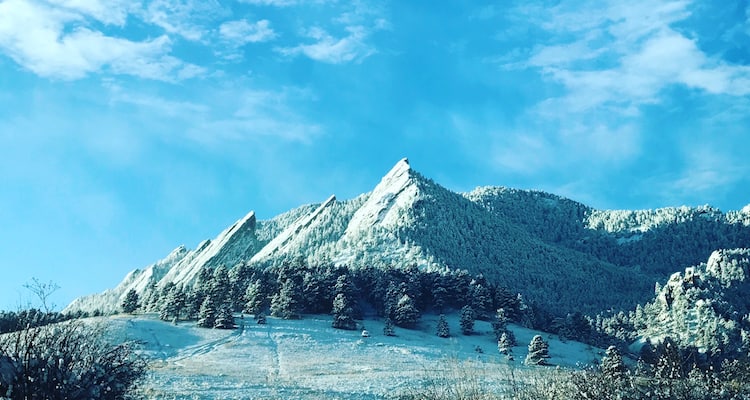
Winter has officially arrived here in Boulder. For fair weather hikers, that means packing away the trail shoes and switching to other activities for the next few months. For prepared all-season hikers, it means… jackpot! With fewer people on the trails and spectacular snowy vistas, winter is the absolute best season for hiking in Boulder. The key is having the right gear and knowing where to go.
Winter days on the Front Range can be mild and sunny or icy and blustery. Paying attention to the forecast and trail conditions is paramount. Packing and dressing appropriately can make the difference between the worst hike ever and the best. Fortunately, the gear needed for winter hiking is minimal and relatively inexpensive compared to other winter sports. With just a couple critical items, you’ll be ready to go.
Once you’re geared up, it’s important to choose trails that are conducive to successful winter hiking. Trails that allow for ample sun will naturally be more pleasant. Some shelter from the wind is also nice. And any opportunity to take in some incredible wintery views will make it worth your while.
Are you convinced yet? If you’re ready to hit Boulder’s snowy trails, read on for everything you need to know.
Prep Work
Before heading out, check the weather forecast and prepare accordingly. And then prepare for something a little bit worse. Colorado weather is infamously unpredictable and storms can arise seemingly out of nowhere. Always pack and dress for the forecast but be prepared just in case things take a turn for the worse.
No matter the season, hiking with a buddy is safest and that’s especially true in winter. Minor accidents can turn pretty major when snowdrifts, icy slopes, and inclement weather are in the mix. A buddy can go get help if needed, which is especially critical in areas where cell service is spotty. Along those lines, always tell someone where you’re hiking and when you expect to return.
Lastly, be sure to visit the appropriate websites for updated trail conditions and possible closures. The City of Boulder’s Open Space and Mountain Parks maintains an up-to-the-minute interactive map showing all trails and area closures. Boulder County regularly posts trail conditions and temporary closures along with the latest Ranger tweets.
Gear Up
Now that you’ve done your research on weather and trail conditions, it’s time to gear up. With a few extra items in your hiking arsenal, hitting the trails all winter long is a piece of cake. While individual needs may vary, here are your winter hiking essentials:
- Foot traction (IceTrekker Diamonds or Kahtoola Microspikes are best)
- Trekking poles
- Breathable wicking layers
- Waterproof jacket
- Waterproof trail shoes or boots
- Gaiters, if deep snow is anticipated
- Headlamp (it gets dark quickly out there!)
- Hat and gloves
- Extra socks (cold wet feet are the worst)
- Insulated thermos for hot tea or coffee (optional but awesome)
- The Ten Essentials that you should ALWAYS have with you
You may also choose to invest in snowshoes depending on where and when you plan to hike. For your run-of-the-mill winter hiking in Boulder, they’re rarely necessary. Our snow melts quickly and, unless you’re the first one out after a big storm, the trails are usually packed down. If you intend to hike at higher elevations (such as Rocky Mountain National Park or Indian Peaks Wilderness), then snowshoes are strongly recommended.
Hike On
You’ve done your research and you’re geared up. It’s time to hit the trails already! Lucky us – Boulder is home to countless trails that make for excellent winter hikes. Here are three all-level options that maximize everything winter has to offer – right in our own backyard.
Wonderland Lake (1.5 miles, negligible elevation gain)
Perhaps more of a walk than a hike, Wonderland Lake is a great way for people of all ages and fitness levels to experience the beauty of winter in Boulder. The easy going trail encircles a wildlife-rich wetland habitat while offering serene views of the foothills. After a dusting snow, it’s a picture perfect scene that is sure to delight winter wanderers. For a longer, more challenging hike, use the Foothills Trail to connect to Old Kiln and/or Hogback Ridge.
Shanahan Ridge – Big Bluestem (2.5 to 5 miles, 800 feet of elevation gain or less)
This network of trails in South Boulder can be combined in a number of ways. Consult the map for several possible loops. The shortest is a mere 2.5 miles with negligible elevation gain, lots of sun, and incredible views of both the city and Boulder’s peaks. The longer loop including Mesa Trail provides a more strenuous workout. The variety of plant and animal life here, along with stellar views, makes for a perfect winter sojourn.
Green Mountain West Ridge (2.6 miles with 600 feet of elevation gain)
Summiting Green Mountain from bottom to top is no small feat in winter. But from the lesser-known West Ridge Trail, it’s accessible to most levels. There is often much more snow on this trail than what’s visible in town, so be prepared.
The trail begins 5 miles up Flagstaff Road and gently rolls along to the junction with Ranger and EM Greenman Trails. From this point, a steep but short series of switchbacks will take you to the summit. Green Mountain West Ridge is the best way to bag a winter summit without investing a whole day. Enjoy the solitude above 8,000 feet and incredible views of the snow-capped peaks to the west.
Happy winter trails (and New Year), Boulderites!
Photo credit: Alli Fronzaglia for YourBoulder.com — all rights reserved




